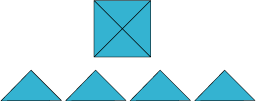Copyright © University of Cambridge. All rights reserved.
'Four Triangles Puzzle' printed from https://nrich.maths.org/
Show menu
Why do this problem?
This low threshold high ceiling task invites learners to be creative with a familiar triangle in a systematic and logical way. It can develop understanding of angles and right angles, and encourages children to visualise.Possible approach
You could use large triangles to introduce this activity on the board. Alternatively, the simple interactivity would be a good place to start. Pose the problem for the children and perhaps invite one or two to come to the board/interactivity to manipulate the triangles. This will help establish the "rules". Leave learners to try out more ideas in pairs, using cut-out triangles. This sheet could be printed out on coloured paper for children to use. It will make 48 small triangles. Recording could be done on square dotty paper or cm squared paper.
After a little while, bring the group together to share ways of working. Invite pairs to describe how they are going about finding the triangles. This will lead into a discussion of finding a system for making successive arrangements, which means it is less likely any will be left out. Some children might have looked at just two triangle arrangements to start with, then those with three
triangles. Simplifying in this way can be very powerful in mathematics and you may want to suggest this even if none of the children have tried it. At this point, it may also be appropriate to talk about how they are checking that each arrangement is in fact different to the others.
The patterns produced during this investigation, along with descriptions about how they were found, would make a lovely classroom display.
Key questions
Does it make a difference if you turn one triangle over in this arrangement?How are you making sure all your patterns are different?
Possible extension
Some children will be able to justify that they have found all the possible variations. You could challenge them to predict and explain how many different arrangements there will be for other numbers of triangles.
